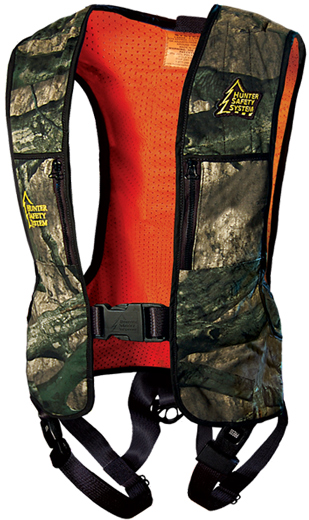Sept. 15, 2011
By Art Lander Jr.
FRANKFORT, Ky. – A fall from a treestand is no laughing matter.
The consequences can be life-changing, much worse than a sprained ankle or broken arm. Each season deer hunters are paralyzed for life or killed in falls because they overlooked the most important safety precautions.
“We’re really pushing the importance of wearing a full-body harness and attaching a safety line to the tree,” said Bobby McKee, bowhunting education coordinator for the Kentucky Department of Fish and Wildlife Resources. “A fall from a treestand can happen to any hunter, even the most experienced.”
Falls from treestands are the most prevalent hunting accident in the southeastern U.S. McKee said.

Kentucky Fish and Wildlife annually receives about five to six reports of falls from treestands, but McKee suspects that many more go unreported. “We usually don’t find out about them unless it’s a serious injury or fatality,” he said.
A fall can happen at any time for a number of reasons. Snow or ice can make treestand steps slippery and platforms can break or come apart where they’re attached to the tree. Several years ago, there was a fatal accident in Land Between the Lakes when a hunter nodded off and fell head first out of his treestand.
“Falls typically occur at the platform level, when the hunter is stepping onto or out of the treestand,” McKee said. “In Kentucky, 25 percent of our hunting incidents are falls from treestands and 25 percent of these falls are fatal.”
A full body harness is the only approved safety option because the hunter’s weight is supported evenly by padded chest and leg straps. Waist belts or chest harnesses can cause severe trauma in seconds by cutting off blood flow and compressing the chest, affecting the ability to breathe.
“I recommend hunters get a foot or two off the ground and practice hanging in their full-body harness to get used to how it feels,” McKee said.
At ground level, hunters should also practice re-entering the stand if they fall off the seat.
“It’s important that there’s no slack in the tether that connects the harness to the tree belt,” McKee said. “It should be set so that the hunter can’t fall below the platform. Put the tree belt around the tree at eye level or higher when standing in the treestand.”
The danger of hunting from treestands is compounded by the heights to which some deer hunters climb to escape the eyes and nose of their quarry. The higher a hunter climbs, the higher the risk.
“There’s no recommended height to climb,” McKee said. “In most terrain, with adequate foliage for cover, 10 to 14 feet is usually high enough. A more important question might be whether the tree is capable of supporting me at the height I want to climb.”
Avoid dead or diseased trees and never trust wooden steps nailed into trees. Don’t put your weight on tree limbs when climbing.
Some treestand safety tips from the Treestand Manufacturer’s Association (TMA):
1. Read and understand the manufacturer’s warnings and instructions before using the treestand. Practice with the treestand at ground level prior to hunting. Save your treestand instruction booklets for later review or to pass on to anyone borrowing (or buying) your stand.
2. Never exceed the weight limit of the treestand as specified by the manufacturer.
3. Inspect the treestand, full-body harness and safety line for signs of wear or damage before each use.
4. Be aware that prolonged suspension in the most comfortable full-body harnesses could result in serious injury or death. Have a plan for rescue. Take along a cell phone or two-way radio to call for help, if needed. Before you leave home, let others know your exact hunting location and when you plan to return.
5. Never leave a treestand installed for long periods of time since damage could result from wind, weather or prolonged exposure to sunlight, which can rot the nylon straps that hold to the stand to the tree.
6. Use a haul line to pull up your gear, unloaded firearms or bow and arrows to your treestand once you have reached your desired hunting height. Never climb with anything in your hands. Prior to descending, lower your equipment on the opposite side of the tree.
7. Know your physical limitations. Don’t take chances. Take your time when using a climbing treestand; make slow, even movements of no more than 10 to 12 inches at a time. Make sure you have proper contact with the tree and your treestand every time you move.
8. On ladder-type treestands, maintain three points of contact with each step – two hands and one foot, or two feet and one hand.
9. When hunting from fixed position treestands, use the lineman’s belt feature of the full-body harness when ascending or descending the ladder or climbing sticks. Remember to climb up above the platform and step down onto it.
To view a treestand safety video, download a list of safety recommendations and find out about treestand recalls, visit the TMA website at: http://www.tmastands.com.
Author Art Lander Jr. has been writing about the outdoors since the 1970s. He is a staff writer for Kentucky Afield Magazine.
-30-
Contact: Art Lander, Jr.
1-800-858-1549, ext. 4414
The Kentucky Department of Fish and Wildlife Resources manages, regulates, enforces and promotes responsible use of all fish and wildlife species, their habitats, public wildlife areas and waterways for the benefit of those resources and for public enjoyment. Kentucky Fish and Wildlife is an agency of the Tourism, Arts and Heritage Cabinet. For more information on the department, visit our website at fw.ky.gov.



Be the first to comment